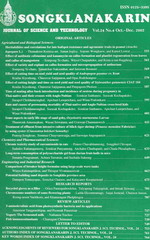ThaiScience
ThaiScience
SONGKLANAKARIN JOURNAL OF SCIENCE & TECHNOLOGY
Volume 42, No. 02, Month MARCH, Year 2020, Pages 430 - 438
Depositional environments of the meandering pran buri river, southwestern thailand during the last 1000 years
Wickanet Songtham, Parichat Kruainok, Paramita Punwong, Dallas C. Mildenhall
Abstract Download PDF
A 370 cm long sedimentary core was investigated using paleoecological proxies to reconstruct environmental changes of the meander bend in Pak Nam Pran area, the Malay-Thai Peninsula during the last millenniums. The sedimentary profile can be divided into four biozones based on their dominant palynomorphs. The Micrasterias zone represents a back swamp on the floodplain deposited around 1800 years before present (B.P.) until 1,500 years B.P. After that, the younger Ilex zone represents a swampy area with Ilex trees until 1,000 years B.P. The younger Cyclotella striata zone represents the swampy area near the Pran Buri riverbank up to 150 years B.P. indicating an ongoing marine regression during the last millennium. The youngest Rhizophoraceae zone indicates a mangrove forest occurring from 150 years B.P. with seawater intrusions during daily high tides. Moreover, recent human activities are also recorded within the area indicated by strongly enhanced elements at the top of the core.
Keywords
Pran Buri River, meandering river course, marine incursion, palynology, mangroveSONGKLANAKARIN JOURNAL OF SCIENCE & TECHNOLOGY
Published by : Prince of Songkla University
Contributions welcome at : http://rdo.psu.ac.th
